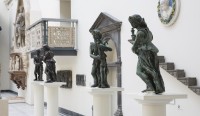 Four bronze angels created for the never-completed tomb of Cardinal Thomas Wolsey, lost for centuries, could be scattered again if we can’t raise £1,540,247 by December 31st. As of right now, £3,459,753 has been raised, thanks to a £2 million grant from the National Heritage Memorial Fund, £500,000 from the Art Fund and donations from individuals through the Victoria & Albert museum’s Wolsey Angels Appeal. I really cannot emphasize enough how much of a monstrous travesty losing the Wolsey Angels would be.
Four bronze angels created for the never-completed tomb of Cardinal Thomas Wolsey, lost for centuries, could be scattered again if we can’t raise £1,540,247 by December 31st. As of right now, £3,459,753 has been raised, thanks to a £2 million grant from the National Heritage Memorial Fund, £500,000 from the Art Fund and donations from individuals through the Victoria & Albert museum’s Wolsey Angels Appeal. I really cannot emphasize enough how much of a monstrous travesty losing the Wolsey Angels would be.
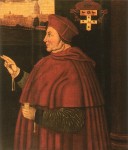 It was Cardinal Wolsey himself, at the peak of his power in 1524, 10 years after he was appointed Cardinal Archbishop of York, on his ninth year as Lord Chancellor to King Henry VIII, who commissioned the angels from Florentine sculptor and architect Benedetto da Rovezzano. Benedetto was famous by then as a builder of tombs for the notables of the short-lived Florentine Republic, church reliefs, statues for sepulchral monuments to saints. His Republican sympathies and wholesale loss of patrons after the re-establishment of the Medici rule ultimately drove him out of Florence. In 1519 he moved to London and remained there for 24 years, making sculptures and tombs for the royal court.
It was Cardinal Wolsey himself, at the peak of his power in 1524, 10 years after he was appointed Cardinal Archbishop of York, on his ninth year as Lord Chancellor to King Henry VIII, who commissioned the angels from Florentine sculptor and architect Benedetto da Rovezzano. Benedetto was famous by then as a builder of tombs for the notables of the short-lived Florentine Republic, church reliefs, statues for sepulchral monuments to saints. His Republican sympathies and wholesale loss of patrons after the re-establishment of the Medici rule ultimately drove him out of Florence. In 1519 he moved to London and remained there for 24 years, making sculptures and tombs for the royal court.
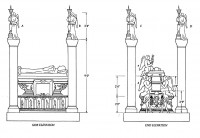 Wolsey’s commission was for a monumental tomb in Renaissance style with an angel standing on pillars nine feet tall in each of the four corners, but his end would come before the tomb was completed and in any case his circumstances had changed, to put it mildly. When Wolsey was unable to secure an annulment of Henry VIII’s marriage to Catherine of Aragon, he wasn’t just fired; he was arrested. In 1529, Henry confiscated Wolsey’s property, including the residence of Hampton Court thenceforth known as Hampton Court Palace and Benedetto da Rovezzano’s four bronze angels and other finished parts of the tomb including the striking black marble sarcophagus. Wolsey died on his way to London to answer to charges of treason in November of 1530.
Wolsey’s commission was for a monumental tomb in Renaissance style with an angel standing on pillars nine feet tall in each of the four corners, but his end would come before the tomb was completed and in any case his circumstances had changed, to put it mildly. When Wolsey was unable to secure an annulment of Henry VIII’s marriage to Catherine of Aragon, he wasn’t just fired; he was arrested. In 1529, Henry confiscated Wolsey’s property, including the residence of Hampton Court thenceforth known as Hampton Court Palace and Benedetto da Rovezzano’s four bronze angels and other finished parts of the tomb including the striking black marble sarcophagus. Wolsey died on his way to London to answer to charges of treason in November of 1530.
 Henry VIII decided he would use the elements of Wolsey’s tomb to make an even grander tomb for himself, and who better to commission than Benedetto da Rovezzano? Benedetto set up a workshop and foundry at Westminster and set to work on the king’s tomb. By 1543, the tomb still wasn’t finished and Benedetto’s health was suffering so he returned to Italy. According to Vasari, Benedetto experienced vertigo and sight impairment as a result of “standing too long over the fire in the founding of metals, or by some other reasons,” and eventually went completely blind. He died around 1554.
Henry VIII decided he would use the elements of Wolsey’s tomb to make an even grander tomb for himself, and who better to commission than Benedetto da Rovezzano? Benedetto set up a workshop and foundry at Westminster and set to work on the king’s tomb. By 1543, the tomb still wasn’t finished and Benedetto’s health was suffering so he returned to Italy. According to Vasari, Benedetto experienced vertigo and sight impairment as a result of “standing too long over the fire in the founding of metals, or by some other reasons,” and eventually went completely blind. He died around 1554.
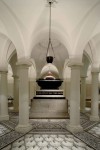 Henry VIII died in 1547 with the tomb incomplete. He was buried with his third wife and mother of his son, Jane Seymour, in St. George’s Chapel, Windsor Castle. His three children — Edward VI, Mary I, and Elizabeth I — each said they’d have the tomb completed and Henry interred in it, but it never happened. In 1565, Elizabeth moved the tomb parts to Windsor where they were still being kept 80 years later when the dislocation of Civil War struck them. With the Parliamentarian victories in 1645, most of the tomb was sold off. Only the black sarcophagus remained at Windsor. Charles I wanted to be buried in it at Westminster Abbey, but the 59 Commissioners who found him guilty of high treason against himself refused permission. Instead he was buried in Henry VIII’s vault in St. George’s Chapel on February 9th, 1649. A suitable use was eventually found for the black coffin: in 1805, King George III gifted the Wolsey-Henry-Charles sarcophagus to serve as a final resting place for Admiral Lord Nelson’s body in the crypt of St. Paul’s Cathedral.
Henry VIII died in 1547 with the tomb incomplete. He was buried with his third wife and mother of his son, Jane Seymour, in St. George’s Chapel, Windsor Castle. His three children — Edward VI, Mary I, and Elizabeth I — each said they’d have the tomb completed and Henry interred in it, but it never happened. In 1565, Elizabeth moved the tomb parts to Windsor where they were still being kept 80 years later when the dislocation of Civil War struck them. With the Parliamentarian victories in 1645, most of the tomb was sold off. Only the black sarcophagus remained at Windsor. Charles I wanted to be buried in it at Westminster Abbey, but the 59 Commissioners who found him guilty of high treason against himself refused permission. Instead he was buried in Henry VIII’s vault in St. George’s Chapel on February 9th, 1649. A suitable use was eventually found for the black coffin: in 1805, King George III gifted the Wolsey-Henry-Charles sarcophagus to serve as a final resting place for Admiral Lord Nelson’s body in the crypt of St. Paul’s Cathedral.
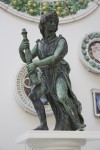 As for the angels, they disappeared after the Civil War fire sale. It took 350 years for them to turn up again. Unmoored from their illustrious history and unrecognized by appraisal exports, two of the angels came up for auction at Sotheby’s in 1994. The catalogue described them as bronze angels “in the Renaissance style,” not realizing they were originals of major historical significance by a name artist. They didn’t even include a photograph accompanying the entry in the catalogue. The pair sold for £12,000. A few years ago, the auction pair were finally recognized. Italian art historian Francesco Caglioti came across them in the possession of a Paris antiques dealer. He researched the angels and found an exact description of them in a 1530 inventory of Wolsey’s property.
As for the angels, they disappeared after the Civil War fire sale. It took 350 years for them to turn up again. Unmoored from their illustrious history and unrecognized by appraisal exports, two of the angels came up for auction at Sotheby’s in 1994. The catalogue described them as bronze angels “in the Renaissance style,” not realizing they were originals of major historical significance by a name artist. They didn’t even include a photograph accompanying the entry in the catalogue. The pair sold for £12,000. A few years ago, the auction pair were finally recognized. Italian art historian Francesco Caglioti came across them in the possession of a Paris antiques dealer. He researched the angels and found an exact description of them in a 1530 inventory of Wolsey’s property.
 Caglioti didn’t stop there. He went on a quest to find the other two angels, and against every conceivable odds, he found them in 2008 at Harrowden Hall, a Northamptonshire estate that was acquired by the Wellingborough Golf Club in the 1970s. Nobody knows when the angels got there; they were already in place when the stately home became a clubhouse. All four of them were there, as a matter of fact, because the two that were sold at Sotheby’s in 1994 had actually been stolen from the Wellingborough Golf Club in 1988. The angels were standing on posts flanking the entrance gates back then. The golf club people just figured one pair had been stolen for their lead value (they had no idea the angels were even bronze) so they moved the surviving pair indoors and wrote off the loss. As soon as they found out they had Wolsey’s Angels, the club lent them to the V&A for safekeeping.
Caglioti didn’t stop there. He went on a quest to find the other two angels, and against every conceivable odds, he found them in 2008 at Harrowden Hall, a Northamptonshire estate that was acquired by the Wellingborough Golf Club in the 1970s. Nobody knows when the angels got there; they were already in place when the stately home became a clubhouse. All four of them were there, as a matter of fact, because the two that were sold at Sotheby’s in 1994 had actually been stolen from the Wellingborough Golf Club in 1988. The angels were standing on posts flanking the entrance gates back then. The golf club people just figured one pair had been stolen for their lead value (they had no idea the angels were even bronze) so they moved the surviving pair indoors and wrote off the loss. As soon as they found out they had Wolsey’s Angels, the club lent them to the V&A for safekeeping.
 Now here is the crux of the travesty. Because of the statute of limitations and the many hands and countries with varying applicable laws the stolen angels have passed through, the Wellingborough Gold Club cannot get the angels back from the Paris dealer. Instead, he’s going to sell his pair to the Victoria & Albert for £2.5 million. He may donate some portion of his filthy lucre to the Golf Club, but then again he may not. The Wellingborough has made the same offer for its pair of angels (they can’t be sold to the highest bidder because they are part of the heritage listing of Harrowden Hall) which is why it will cost £5 million to save the four Wolsey Angels for the nation.
Now here is the crux of the travesty. Because of the statute of limitations and the many hands and countries with varying applicable laws the stolen angels have passed through, the Wellingborough Gold Club cannot get the angels back from the Paris dealer. Instead, he’s going to sell his pair to the Victoria & Albert for £2.5 million. He may donate some portion of his filthy lucre to the Golf Club, but then again he may not. The Wellingborough has made the same offer for its pair of angels (they can’t be sold to the highest bidder because they are part of the heritage listing of Harrowden Hall) which is why it will cost £5 million to save the four Wolsey Angels for the nation.
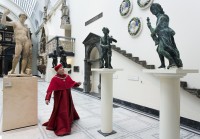 Hilary Mantel, author of the Tudor-era historical novels Wolf Hall and Bring Up the Bodies, had this to say about the rediscovery of the Wolsey Angels:
Hilary Mantel, author of the Tudor-era historical novels Wolf Hall and Bring Up the Bodies, had this to say about the rediscovery of the Wolsey Angels:
“Thanks to the discovery of Wolsey’s angels, a great Englishman we have forgotten may have his monument at last. The recovery of Wolsey’s angels is one of those miracles that historians pray for; something that seems irrevocably lost has been there all the time. To claim the angels for the nation would connect us to one of the liveliest eras of our history and one of its most remarkable men.”
I asked Brodie Lyon, the V&A’s Annual Fund and Appeals Manager, if there was another large grant in the works to make up for the alarming shortfall and there was none that he could announce publicly, which I hope means there are arrangements going on in the background but could just as well mean that there is no plan B. We need a last minute fundraising push because if this sale doesn’t go through, it looks like those two Paris angels could wind up anywhere in the world and there isn’t a damn thing the law can do about it even though there is no dispute about the fact that they’re stolen goods of immense cultural significance to Britain.
Why can’t our galleries and museums sell off some of the stuff in storage that the public never, or rarely, sees, to fund purchases such as these? Obviously they can’t sell anything they were left on trust, but surely they must have lots of stuff without such legal or moral constraints.
Why can’t one bring this to the Royal Family’s attention and ask them to donate the money? Or just buy it outright and gift the 4 angels to the V&A museum? I think the Royal Family might consider it since it is part of the Nation’s history.
Saxons claiming angels ? – It is not possible to legally own stolen goods, and hence impossible to legally sell them. We have every reason to suspect, therefore, what has been referred to as a ‘not very anglican’ plot, and the English seem indeed to have a certain tradition of how these issues should be dealt with: Let us avoid details, but a sarcophagus wont be needed for this.
The black sarcophagus, however, i.e. without all that other hevenly bling bling – honestly – is one of the coolest ones ever: Who wouldn’t like to be buried in there, or maybe better bury somebody else ? There are typos: ‘a great Englishman we have forgotten may have his monument at last’ and ‘Charles I wanted to buried in it’, but why worry: There might have been something wrong with the plot.
Maybe w kinr ot payback for all the pretty stuff the English stole from other places and stubbornly keep in their own museums. (Sorry about that… needed saying.) The angels are lovely, but no more meaningful than many items that are still in British museums that belong to other peoples.
Is there an update on this? I can’t get the BT site to take my donation because they aren’t set up for correct US addresses. I’ve put out the word but the BT site’s last donation is listed as October.
These need to be saved. Anyone have the MP email list?